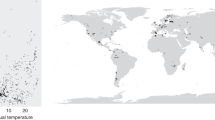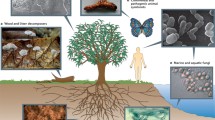Abstract
Recent estimates of the global species numbers of fungi suggest that the much-used figure of 1.5 million is low, and figures up to 5.1 million have been proposed in the last few years. Data emerging from tropical studies, and from large-scale sequencing of environmental samples, have the potential to contribute towards a more robust figure. Additional evidence of species richness is coming from long-term studies of particular non-tropical sites, and also from molecular phylogenetic studies revealing extensive cryptic speciation. However, uncertainties remain over fungus:plant species ratios and how they should be extrapolated to the global scale, and also as to the geographical distribution of fungi known only as sequences. Also unclear is the extent to which figures should be modified to allow for insect-associated fungi. The need for comprehensive studies, especially in the tropics, to address the uncertainties used in past extrapolations, is stressed. For the present, it is recommended that the phrase “at least 1.5, but probably as many as 3 million” be adopted for general use until some of the current uncertainties are resolved.
Similar content being viewed by others
References
Adl SM, Leander BS, Simpson AGB, Archibald JM, Anderson RO, Bass D, Bowser SS, Brugerolle G, Farmer MA, Karpov S, Kolisko A, Lane CE, Lodge DJ, Mann DG, Meisterfield R, Medoza L, Moestrup O, Mozley-Standridge SE, Smirnov AV, Spiegel F (2007) Diversity, nomenclature, and taxonomy of protists. Syst Biol 56:684–689
Bass D, Richards TA (2011) Three reasons to re-evaluate fungal diversity ‘on Earth and in the ocean’. Fungal Biol Rev 25:159–164
Bass D, Howe A, Brown N, Barton H, Demidova M, Michelle H, Li L, Sanders H, Watkinson SC, Willcock S, Richards TA (2007) Yeast forms dominate fungal diversity in the deep oceans. Proc R Soc Lond B 274:2069–3077
Bensch K, Groenewald JZ, Dijksterhuis J, Starink-Willemse M, Andersen B, Summerell BA, Shin H-D, Dugan FM, Schroers H-J, Braun U, Crous PW (2010) Species and ecological diversity within the Cladosporium cladosporioides complex (Davidiellaceae, Capnodiales). Stud Mycol 67:1–94
Berndt R (2012) Species richness, taxonomy and peculiarities of the neotropical rust fungi. Are they more diverse in the neotropics. Biodivers Conserv 21. doi:10.1007/s10531-011-0220-z
Blackwell M (2011) The fungi: 1, 2, 3. 5.1 million species? Am J Bot 98:426–438
Brasier CM (1987) The dynamics of fungal speciation. In: Rayner ADM, Brasier CM, Moore D (eds) Evolutionary biology of the fungi. Cambridge University Press, Cambridge, pp 231–260
Buée M, Reich M, Murat C, Morin E, Nilsson RH, Uroz S, Martin F (2009) 454 Pyrosequencing analyses of forest soils reveal an unexpectedly high fungal diversity. New Phytol 184:449–456
Chapman AD (2009) Numbers of living species in Australia and the world, 2nd edn. Australian Biological Resources Survey, Canberra
Crespo A, Lumbsch HT (2010) Cryptic species in lichen-forming fungi. IMA Fungus 1:167–170
Deshmukh SK, Rai MK (eds) (2005) Biodiversity of fungi: their role in human life. IBH Publishing, New Dehli
Geml J, Nouhra ER, Wicaksono CY, Pastor N, Fernandez L, Becerra AG (2012) Mycota of the Andean Yungas forests: assessments of fungal diversity and habitat partitioning in a threatened ecosystem. Inoculum 63(3):18
Griffith GW, Baker S, Fliegerova K, Liggenstoffer A, van der Giezen M, Voigt K, Beakes G (2010) Anaerobic fungi: Neocallimastigomycota. IMA Fungus 1:181–185
Hawksworth DL (1991) The fungal dimension of biodiversity: magnitude, significance, and conservation. Mycol Res 95:641–655
Hawksworth DL (2001) The magnitude of fungal diversity: the 1.5 million species estimate revisited. Mycol Res 105:1422–1432
Hawksworth DL, Rossman AY (1997) Where are all the undescribed fungi? Phytopath 87:888–891
Hawksworth DL, Minter DW, Kinsey GC, Cannon PF (1997) Inventorying a tropical fungal biota: intensive and extensive approaches. In: Janardhanan KK, Rajendran C, Natarajan K, Hawksworth DL (eds) Tropical mycology. Science Publishers, Enfield, pp 29–50
Henkel TW, Aime MC, Chin MML, Miller SL, Vilgalys R, Smith ME (2012) Ectomycorrhizal fugal sporocarp diversity and discovery of new taxa in Dicymbe monodominant forests of the Guiana Shield. Biodivers Conserv 21. doi:10.1007/s10531-011-0166-1
Hibbett DS, Ohman A, Glotzer D, Nuhn M, Kirk P, Nilsson RH (2011) Progress in molecular and morphological taxon discovery in Fungi and options for formal classification of environmental sequences. Fungal Biol Rev 25:38–47
Hosagoudar VB (2008) Meliolales of India, vol 2. Botanical Survey of India, Kerala
Hyde KD (ed) (1997) Biodiversity of tropical microfungi. Hong Kong University Press, Hong Kong
Isaac S, Frankland JC, Watling R, Whalley AJS (eds) (1993) Aspects of tropical mycology. Cambridge University Press, Cambridge
Janardhanan KK, Rajendran C, Natarajan K, Hawksworth DL (eds) (1997) Tropical mycology. Science Publishers, Enfield
Jones MDM, Forn L, Gadelha C, Egan MJ, Bass D, Massana R, Richards TA (2011) Discovery of novel intermediate forms redefines the fungal tree of life. Nature 474:200–203
Kirk PM, Cannon PF, Minter DW, Stalpers JA (2008) Ainsworth & Bisby’s dictionary of the fungi, 10th edn. CAB International, Wallingford
Le Calvez T, Burgaud G, Mahé S, Barbier G, Vandenkoornhuyse P (2009) Fungal diversity in deep-sea hydrothermal ecosystems. Appl Environ Microbiol 75:6415–6421
Lentednu G, Zinger L, Manel S, Coissac E, Choler P, Geremia RA, Melodelima C (2011) Assessment of soil fungal diversity in different alpine tundra habitats by means of pyrosequencing. Fungal Divers 49:113–123
López-Quintero CA, Straatsma G, Franco-Molano AE, Boekhoet T (2012) Macrofungal diversity in Colombian Amazon forests varies with regions and regimes of disturbance. Biodivers Conserv 21. doi:10.1007/s10531-012-0280-8,10.1007/s10531-012-028-94-2
McGuire KL, Fierer N, Bateman C, Treseder KK, Turner BL (2011) Fungal community composition in neotropical rain forests: the influence of tree diversity and precipitation. Microb Ecol. doi:10.1007/s00248-011-9973-x
Mora C, Tittensor DP, Adl S, Simpson AGB, Worm B (2011) How many species are there on earth and in the ocean. PLoS Biol 9(8):e1001127
Mueller GM, Bills GF, Foster MS (eds) (2004) Biodiversity of fungi: inventory and monitoring methods. Elsevier, Amsterdam
O’Brien BL, Parrent JL, Jackson JA, Moncalvo JM, Vilgalys R (2005) Fungal community analysis by large-scale sequencing of environmental samples. Appl Env Microbiol 71:5544–5550
Petersen RH, Hughes K (2012) The “Big Ditch” project: trans-Atlantic mushroom disjunction tested using multiple taxonomic tools. Inoculum 63(3):37–38
Piepenbring M, Hofmann TA, Unterseher M, Kost G (2012) Species richness of plants and fungi in western Panama—towards a fungal inventory in the neotropics. Biodivers Conserv 21. doi:10.1007/s10531-011-0213-y
Raghukumar C, Damara S (2008) Deep sea fungi. In: Michiels C, Bartlett DH, Aertsen A (eds) High-pressure microbiology. American Microbiological Society Press, Washington, DC, pp 265–292
Rosling A, Cox F, Cruz-Martinez K, Ihrmark K, Grelet GA, Lindahl BD, Menkis A, James TY (2011) Archaeorhizomycetes: unearthing an ancient class of ubiquitous soil fungi. Science 333:876–879
Rossman AY, Tulloss RE, O’Dell TE, Thorn RG (1998) Protocols for an all taxa biodiversity inventory of fungi in a Costa Rican conservation area. Parkway Publishers, Boone
Ruibal C, Gueidan C, Selbmann L, Gorsbushina AA, Crous PW, Groenewald JZ, Muggia L, Grube M, Isola D, Schoch CL, Staley JT, Lutzoni F, de Hoog GS (2009) Phylogeny of rock-inhabiting fungi related to Dothideomycetes. Stud Mycol 64:123–133
Scheffers BR, Joppa LN, Pimm SL, Laurance WF (2012) What is known about Earth’s missing biodiversity. Trends Ecol Evol. doi:10.1016/j.tree2012,05.008
Schmit JP, Mueller GM (2007) An estimate of the lower limit of fungal diversity. Biodivers Conserv 16:99–111
Setaro SD, Garnica S, Herrera PI, Suárez JP, Göker M (2012) A clustering optimization strategy to estimate species richness in Sebacinales in the tropical Andes based on molecular sequences from distinct DNA regions. Biodivers Conserv 21. doi:10.1007/s10531-011-0205-y
Taylor DL, Herriott IC, Stone KE, McFarland JW, Booth MG, Leigh MB (2010) Structure and resilience of fungal communities in Alaskan boreal forest soils. Can J For Res 40:1288–1301
Vega FE, Blackwell M (eds) (2005) Insect-fungal associations: ecology and evolution. Oxford University Press, Oxford
Watling R, Frankland JC, Ainsworth AM, Isaac S, Robinson CH (eds) (2002) Tropical mycology, 2 vols. CAB International, Wallingford
Acknowledgments
M. Catherine Aime, Conrad L. Schoch, and Brian M. Spooner are thanked for providing previously unpublished data, three referees and the Editors for making several constructive suggestions, and my wife, Patricia E. J. Wiltshire-Hawksworth, for improving the clarity of my draft and for critical comments. This work was undertaken while in receipt of funding from the Ministerio de Economía y Competitividad of Spain under project CGL2011-25003.
Author information
Authors and Affiliations
Corresponding author
Rights and permissions
About this article
Cite this article
Hawksworth, D.L. Global species numbers of fungi: are tropical studies and molecular approaches contributing to a more robust estimate?. Biodivers Conserv 21, 2425–2433 (2012). https://doi.org/10.1007/s10531-012-0335-x
Received:
Accepted:
Published:
Issue Date:
DOI: https://doi.org/10.1007/s10531-012-0335-x




